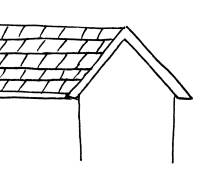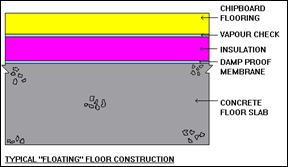We can provide help and advice with regard to timber frame properties; both old and new, building surveys, structural surveys, home buyers reports, valuations, property reports, schedules of condition, damp reports, specific defects report, or any other property matters.
Our surveys contain easy to understand sketches and photos, together with any problems we find and solutions to those problems, along with an anticipated cost for any works. We recommend you meet us at the property during the survey for us to answer any questions.
Please contact us on free phone 0800 298 5424 for a friendly chat with a surveyor.
Property problem information sheets
This is one article in a series of articles covering different property eras and their typical problems. We have looked at:
|
Traditional Tudor timber frame Georgian and Regency Victorian and Edwardian Post-War years Modern timber frame |
In this article we are looking at modern timber frame properties and their associated problems.
We would advise that the property problems can be very specific to the area and location of the property, or even the direction it is facing, i.e. north, south, east or west elevations can each have their individual problems. The defects and problems also relate to the mixture of building materials used, this can range from small repairs to where alterations and extensions have been carried out, and, of course, the age and general standard of the original construction and any additional maintenance that has taken place on taken place on the property. Having said all of that we have given you a general indication of the typical problems that modern timber frame properties have, which we hope will be a useful free guide.
This series of free property problems articles unfortunately cannot be conclusive, as there are whole books, thesis', Phd's, Doctorate studies have been written on smaller subjects!
In this series of problem property articles we have looked at the properties from the top down, much as a surveyor would when carrying out a building survey, or, as it is commonly known, a full structural survey, or an engineers report. You will find different property problems and defects, everything from dampness in the walls to condensation (very difficult to tell the difference between the very different costs in putting right), to articles on cracking, foundations and drains, in the quick link section of the website.
Modern timber frame construction
Characteristics of timber frame construction
This isn't really a style, but we would comment that it does tend to have cladding added in a lot of cases. The cladding can be in the form of render, or timber cladding, or plastic sheet cladding, that looks like grained timber.
Typical problems at high level to the chimneys, flashings, roof verges,roof ridges and roof vents
High level problems
High level problems mean that scaffolding is likely to be required or some form of access platform, be it from a cherry picker or hoist. This can often be where the main costs are when carrying out a project, as health and safety on a building project is of the upmost importance.
Chimney problems
Often no chimneys are included in modern properties, although we have added them in when extending modern properties to add a feature, or more practically, to warm up the new extensions, and we have to be very careful to ensure that the chimneys are suitable and positioned to gain an airflow to allow the chimney to draw and therefore keep the fire alight and not smoke out the rooms, as this is not very pleasant if you get it wrong and also a difficult problem to solve. Also, of course, you need to be considerate to your neighbours and ensure that you are not changing the colour of their washing with the smoke, or even smokeless fuel, as it contains colours and particles.

Roof problems
Predominantly large concrete tiles are used with felt under them, known as underfelt or sarking felt, or a protective layer or breathable felt. The large concrete tiles allow for quick roofing of the property, rather than the smaller tiles in years gone by. We have even come across properties that have had a metal cladding roof.
Problems with air ventilation of the roof void
The venting of the roofs has changed over the years; from the original physical vents in the fascias and soffits, often a running grill, to having vents in the roofs themselves, to progressing on to hidden vents, which became an art to spot, to the use of breathable roofing felt. We certainly agree that roofs should have ventilation. We have been in roofs where literally it has been like being in a rain forest and we have found water dripping off the felt internally and it is just a matter of time before this causes dampness in the property.
Breathable roofing felt problems
Breathable roof felt, we feel, has a potential problem: that is the blocking of the holes within the breathable felt with general dust and dirt will make these roofs susceptible to condensation, particularly with the increased insulation levels that we are putting into properties these days. We have discussed this potential problem at length but have been unable to come up with a solution, other than to put the vents back in!
Roof truss problems
The amount of timber has been engineered to a minimum in modern timber frame properties in the amount of timber used in the roof. We come across problems with the junction of the roof timbers failing (such as coming loose or splitting). Usually this is due to them being stored badly. One tip we would recommend is to look out for mud on the truss rafter. This indicates that they have been laid down when they should have been stood up in storage and problems could be just around the corner.
Fascias and soffits problems
Commonly fascias and soffits were in plastic for many years, with vents in them, although much timber is also used, as it's a renewable resource. The timber tends to have circular vents to the soffits, which can block. In fact, we quite commonly come across birds nesting in the roof and they have got in via the vents and the corners of the fascias and soffits, where they haven't married together properly. There can also, of course, be problems with the plastic fascias and soffits vents being blocked. Probably the most common problem we come across is where the original timber fascias and soffits have been overclad with a plastic fascia and soffits to hide deterioration. Unfortunately, this actually accelerates deterioration, as the moisture, etc, is trapped in them. It does look good temporarily, we could be cynical and say usually whilst the house is sold! So, be aware!
Timber frame construction wall problems
The real difference with a modern property is that it could be timber framed. The outer walls are a cladding of brick, stone or render on an insulation base, with the inner construction being a timber frame.
Originally, a timber frame construction was used in the 1970's. The World in Action BBC TV programme exposé showed how poorly the properties were constructed, in damp and wet conditions and how there was a lack of understanding of how they should be constructed. We believe they originated in Sweden and brought the modern timber frame industry to a halt in the 1970's (interestingly, during a period of boom in the housing market).
The 1980's, 1990's and 2000's this type of construction started to be reused, but, we would argue, still without a full understanding.
Wall trickle vent problems
More recently trickle vents have been used to outer walls, so that any moisture and dampness that got in could be released to the base of the wall, particularly where cavity trays were used, for example, above windows and to the base of the property. We don't believe this type of construction has been in use in Britain long enough to establish what its in use problems are.
Wall Trickle Vents Defined
Small plastic vents that go to the inside of the brick allowing water to transfer from the cavity to the outside world.
Damp proof membrane problems
There is a damp proof membrane, identified as the vapour barrier and also a breather membrane. In our experience, due to poor workmanship, these can be damaged. We anticipate that in future there will be problems where this damage allows dampness into the property.
Gypsum plaster problems
The main problem with modern gypsum plaster is they cannot cope with water or dampness and literally disintegrate.
Windows problems
Typically, casement windows are used but also copy sliding sash windows are sometimes used. These are manufactured in both as plastic double glazed windows and also timber double glazed windows.
Timber window problems
Timber windows tend to use soft wood and can deteriorate quickly if not very regularly maintained. You should look out for trickle vents on windows to ensure that there is some air movement and a flow through the property to minimise condensation.
Plastic window problems
Plastic windows can have a variety of profiles. You have the mullions and transoms, as you view the window, so over the years the forms of plastic used have changed. It is, however, very important to ensure you have trickle vents. We find that when built new the houses will have trickle vents, as it is building regulation requirement, however, where replacement windows are used often savings may be made by not having trickle vents. We have come across problem properties with condensation, where water is literally sitting on the window sills and in the bathrooms and floors, due to lack of trickle vents in the windows.
Windows Trickle Vents Defined
Small vents to the windows to allow air movement inside the property to stop a build up of fumes or humidity.
Floor, foundation and underground problems
Modern concrete suspended floor problems
Modern concrete suspended floors, using a beam and block construction. All first floors constructed from engineers reconstituted timber floor joists.
Modern floating floor problems
Literally a concrete floor, with a timber floor sitting over it.
Foundation problems
Foundations tend to be stripped concrete foundations of 1.2 metres plus, depending upon ground conditions. Interestingly enough, they are deeper than foundations from years ago. Often the problems are either too much concrete, where the builder was being too keen, or too little concrete, where the builder just wanted to go home!

Drainage problems
Clay drains or, probably more commonly, particularly on housing sites, plastic drains used. One of the main problems with these is lack of care when they are being laid, so they are not actually laid to a fall. We are aware of one house where actually ran back into the house!
Internal
Plasterboard problems
Two main problems we come across time and time again; one is a hairline crack between the boards, which is due to differential movement and general settling of the property. It can also be due to structural movement. Another problem that we commonly come across is, what we term, popping. This is where the nails that fix the plasterboard are filled but are exposed when the property moves. By moves we mean it can be as little as someone walking on the first floor and movement or shaking causes the small fillet to pop out over the nail or screw, giving a spotty effect, that needs filling.
A mixture of various styles
Modern properties that have been extended or altered
Although most modern properties that we come across tend to have been built on relatively small plots, some are extendable. Where they have been extended there can be problems, particularly where they join, if there is an awkward roof detail. We have also come across roof problems where people have inadvertently built on the adjoining owner's land, as not as much care seems to be taken with the Deeds as there used to be at one time. Also, conservatories have gone up, without much thought on how they are drained and they discharge directly onto the ground, rather than into soakaways. This can cause problems in the long term.
The other issue that we come across quite a lot is where little thought has been given to how the rainwater should drain from the property, or where it discharges down the downpipes how it should get away.
Towns where modern timber frame properties can be found
Milton Keynes and other new towns, such as Stevenage and Harwich. Any major city from London to Birmingham to Manchester, that has had house building in the 1990's, or the 1970's, tended to use timber frame construction. Some builders have steered away from it, but most have been tempted by the feat of construction and the additional profits.
If you truly do want an independent expert opinion from a surveyor and are particularly interested in carrying out work on modern timber frame properties and if you are buying such a property please look at our survey examples. We feel our surveys are quite unique, as they are written to your level of knowledge. They include photos and sketches and definitions. They include an action required section and an estimate of costs in the executive summary. We are more than happy to meet you at the property to discuss any specific issues you may have or have a general chat about what we have found at the end. P lease contact 0800 298 5424 for a surveyor to give you a call back.
If you have a commercial property, be it leasehold or freehold, then you may wish to look at our Dilapidations Website at www.DilapsHelp.com and for Disputes go to our Disputes Help site www.DisputesHelp.com .
We hope you found the article of use and if you have any experiences that you feel should be added to this article that would benefit others, or you feel that some of the information that we have put is wrong then please do not hesitate to contact us (we are only human).
The contents of the website are for general information only and is not intended to be relied upon for specific or general decisions. Appropriate independent professional advice should be paid for before making such a decision.
All rights are reserved the contents of the website are not to be reproduced or transmitted in any form in whole or part without the express written permission of 1stAssociated.co.uk

